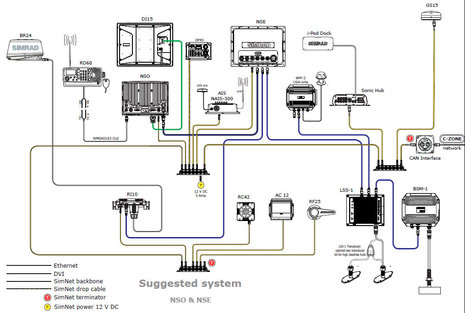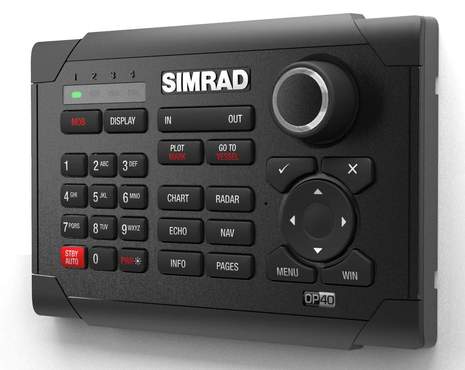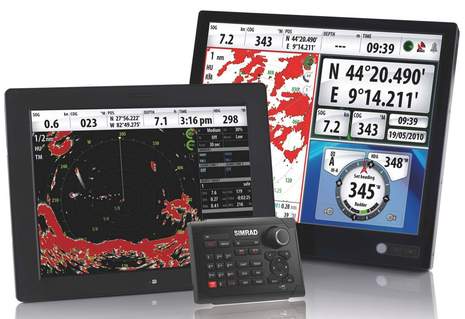Simrad NSO, the NSE series goes big
This week in Newport, and in Southhampton, Simrad introduced the NSO Navigation Series, a black box version of the NSE system, and while it’s hard to imagine an MFD faster than an NSE, even the prototype NSO I fooled with yesterday seemed so. The processor box is, in fact, the same as the one used on the GB40 Glass Bridge system, only with a new 80 gig hard drive and all new software from Linux on up. There will even be an upgrade path for GB40 owners, and I suspect that will be tempting…
The NSO will support all the hardware NSE does — like Broadband Radar and Sonar, StructureScan, HD Radar, SimNet and NMEA 2000 whatever, etc — plus all the app-like functions Simrad added with the NSE 2.0 update — like autopilot control, SonicHub audio, and C-Zone distributed power. A single $4,800 processor can feed up to three monitors (repeat only), and a keypad can run up to four processors. And you can mix NSE 8- and 12-inch MFDs with NSO processors, as illustrated below in one of many possible configurations.

An NSO system can run two radars, but Simrad told me they won’t recommend pairing a BR24 with a pulse radar due to the interference issues. But the pairing will work and in my experience the interference is tolerable if the scanners are mounted distant enough horizontally and/or if the Broadband is set at a close range and the magnetron further out (and they still working to improve the IR). At any rate, NSO sure looks like a smart advancement for Simrad, and possible good news for those already using NSE or GB40 systems. Here, by the way, is a closeup of the new OP40 keyboard, which mimics the NSE (except for the Display/Processor control). It runs on SimNet and a planned software update will allow it to also be used simply as a remote keypad for an NSE.














Played with it at Southampton nice equipment but expensive compared to garmin and raymarine ( who now have nice remote keyboards two even though there marketed for the ” G” series they work on E and Cwide )
Ps played with furuno rd33 I was not that impressed the screen ratio makes the. “dials” look small and compressed. The st70 is better and the star on a price performance has to by garmins gm10
Davw
Count me a noted Simrad fan, but doesn’t this look like a very nice amalgam of Ray G series plus Furuno NN3D plus NSE/NSO?
It does seem that GB60 has has just been effectively retired as well, I see no benefit of using that over this.
I must say that NSO (as in the underlying OS under Lowrance HDS & Simrad NSE) — ouch confusing double use of acronyms here — seems ultra reliable in my use of the past few months. No lock ups or freezes, no unexplained delays – zero. That’s pretty unique in my years of experience with such complicated systems.
Also, I’ve been looking at some internals of how the upgrade process of the NSE/HDS works and I’m impressed — again. Navico not only uses Linux, they use an up-to-date kernel with a file system ( UBIFS developed by Nokia) specifically suited to large flash based systems. This is a level of customization that is seldom seen in the embedded world, where using yesteryear’s kernels and drivers is the norm. It ensures that the system boots quickly even if you powered it off by removing power instead of nicely asking it to shut down. Something expected of chartplotters but not how your average Microsoft Windows system behaves.
hey ben
i was wondering when they are going to make black box version (raymarine, furono, simrad) that works with touch screans (also thirdt party touch screen)
and when garmin is think of making a black box version based of the 5000/7000 serie.
greetings to all!!
Dave, I don’t get your cost concern, as the Raymarine G Processor is a little more expensive, and Garmin doesn’t offer a black box system.
Kees, There’s no doubt that the NSO architecture is similar to G Series and NN3D, but that’s a good thing isn’t it? Incidentally one feature NSO lacks versus the competition, which I failed to mention in the entry, is the ability to handle video either via Ethernet or direct input. But of course video will be seen at an NSO helm by using the video inputs found on some Simrad monitors and many third party monitors.
Greetings to you too, Pascal, but, sorry, I have no answers to your questions. I should write a whole entry about touch versus button & knob interfaces, but in the meantime my short analysis is this: The overall quality of an MFD interface is not dependent on whether it’s touch or button, but rather how well either style was designed.
hello ben
i was affrait of this answer hahaha
but my question is wasnot about the software desing, but more about controle interface.
when you have a blackbox version (dont matter what brand) you will get a keypad/keybord to controle your mdf. and my idea of a blackbox agianst a normal one is space saving on your dash.
so why not skip that keypad (or keep it as a option)and make touch screen support
well i hope this is the next focus of the all the brands to develop this system
it will make it intresstant because i love the touch screen from garmin spacialy with making routes .
Ben, interesting aside on BR24/magnetron interference. Would love to hear more about this as I have been considering adding a BR24 (plus RPCE software when available) as a backup for our NN3D open array. Perhaps I need to rethink that now.
Ben,
The Simrad NSO page, on the supported Navico hardware list, there is mention of a “BR-2” broadband sounder. Any info on that?
I misstyped it sorry…”BSM-2″ is what I meant to type.
Ben said: An NSO system can run two radars, but Simrad told me they won’t recommend pairing a BR24 with a pulse radar due to the interference issues. But the pairing will work and in my experience the interference is tolerable if the scanners are mounted distant enough horizontally and/or if the Broadband is set at a close range and the magnetron further out (and they still working to improve the IR).
Did you mean to say separated vertically? About setting the ranges like that (and it would be the natural thing to do), the BR24 interference pattern is a line to the pulse radar which implies the range setting has little to do with it. I think you could even get the interference line from radars which are off the display. In general, I think the BR24 interference from pulse radars is not a problem, but running a pulse radar on your own boat may be pushing it too far. I’d love to hear more about this.
Does anybody know what the IP rating is for the displays that are part of the NSO system? This information seems missing from Simrad’s website and manuals. I’m hoping for full IP67, connectors and all. Mounted vertically and driven by Ockam’s Vysion system, these displays would make a great mastbase display for racing. Assuming of course that they’re daylight viewable.
It’s really too bad that Vysion and Expedition are both Windows apps. I’m sure the NSO processor could be made to run 3rd party software, and having the functionality of those two packages would be a lot more useful to me than a fishfinder.
Hey Nick, what do you say to a Linux version of Expedition?
DI10 and DI15 are IPX6
hendrik
You’re right, Norse, I meant vertical. The more vertical distance between a BR24 and a pulse radar, the less the latter will interfere with the Broadband. I also think you want a minimal horizontal distance, in other words have the radars stacked vertically, so the BR24 is not in the other’s line of fire.
That said, I had pretty good luck running a BR24 and Garmin xHD 6Kw open array simultaneously yesterday, even though the xHD is only about 6 feet above the BR and it’s maybe 8 feet behind it. You can see their relative positions by looking at the header picture on the Forum (the xHD is where the Garmin 24 HD was last year).
Setting the BR24 to High IR (interference rejection) eliminated virtually all spoking caused by the xHD, even when both were at the same ranges. However, the high IR setting also seems to filter out some BR target detail and intensity, and whereas the spoking is almost all aft and the BR24 can’t see back through the flying bridge anyway, I prefer running with Medium IR.
The Raymarine RD418HD radome causes even less interference, which makes sense as it’s only 4kw and mounted slightly higher than the xHD. Thus I think Simrad’s recommendation not to run pulse and Broadband simultaneously is pretty conservative.
Nick, I don’t have specifics on the next generation BSM-2 Broadband Sonar yet, but the rumors are intriguing. Phenomenal resolution and depth penetration, and maybe even support for “chirp” transducer technology…is what I’ve heard. Full details here next week, I’m hoping.
Gee,and I just ordered a Simrad system with a BSM-1 sounder.
Nothing like having something get superceded before you
even receive it!
BSM-1 is good as well.
I bet the price of the BSM-2 will be a little different as well.
Can’t wait for the LSS-2
hendrik
Thanks Hendrik,now I am really disturbed. I did order a LSS-1 as well.
Ah well, there’s no way to stay completely state of the art all of the time.
Any word on what the resolution of the NSO will be, particularly when hooked to a 3rd party monitor? I’d be very interested in running it with 16:9 displays, if that’s possible (I like the form factor). I tried prowling the simradyachting.com site and got nothin’.
–N